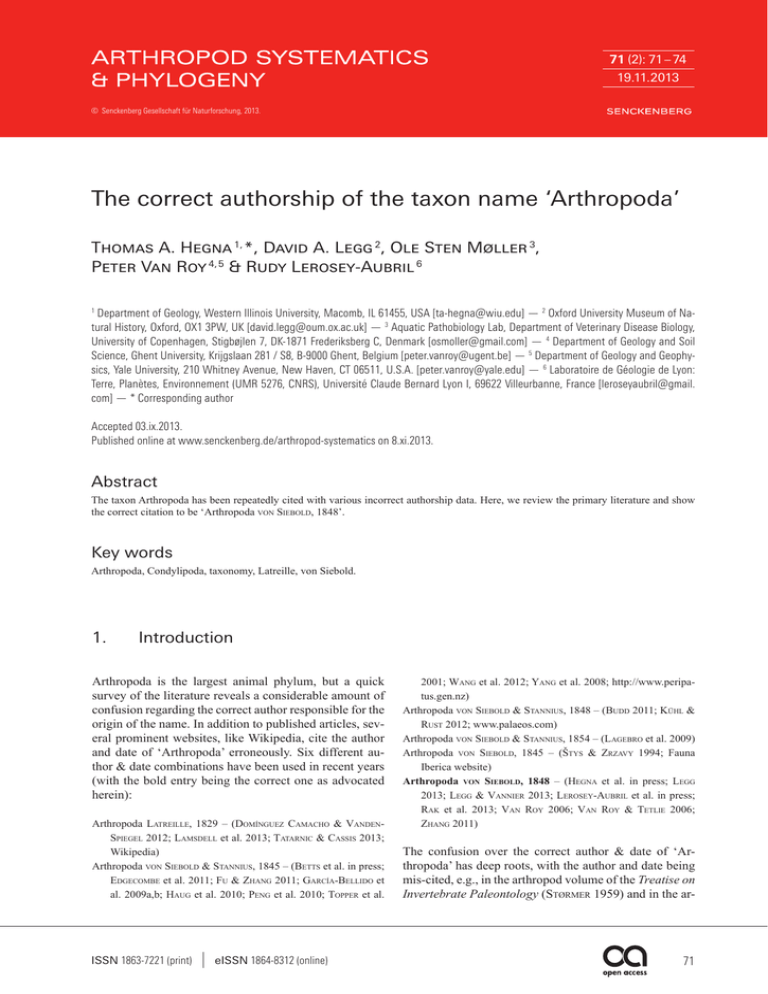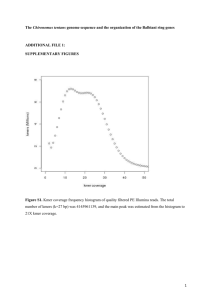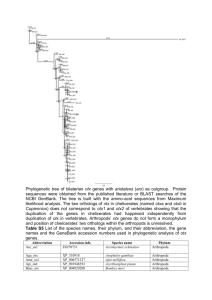The correct authorship of the taxon name ‘Arthropoda’ Thomas A. Hegna
advertisement

71 (2): 71 – 74 19.11.2013 © Senckenberg Gesellschaft für Naturforschung, 2013. The correct authorship of the taxon name ‘Arthropoda’ Thomas A. Hegna 1, *, David A. Legg 2, Ole Sten Møller 3, Peter Van Roy 4, 5 & Rudy Lerosey-Aubril 6 Department of Geology, Western Illinois University, Macomb, IL 61455, USA [ta-hegna@wiu.edu] — 2 Oxford University Museum of Natural History, Oxford, OX1 3PW, UK [david.legg@oum.ox.ac.uk] — 3 Aquatic Pathobiology Lab, Department of Veterinary Disease Biology, University of Copenhagen, Stigbøjlen 7, DK-1871 Frederiksberg C, Denmark [osmoller@gmail.com] — 4 Department of Geology and Soil Science, Ghent University, Krijgslaan 281 / S8, B-9000 Ghent, Belgium [peter.vanroy@ugent.be] — 5 Department of Geology and Geophysics, Yale University, 210 Whitney Avenue, New Haven, CT 06511, U.S.A. [peter.vanroy@yale.edu] — 6 Laboratoire de Géologie de Lyon: Terre, Planètes, Environnement (UMR 5276, CNRS), Université Claude Bernard Lyon I, 69622 Villeurbanne, France [leroseyaubril@gmail. com] — * Corresponding author 1 Accepted 03.ix.2013. Published online at www.senckenberg.de/arthropod-systematics on 8.xi.2013. Abstract The taxon Arthropoda has been repeatedly cited with various incorrect authorship data. Here, we review the primary literature and show the correct citation to be ‘Arthropoda von Siebold, 1848’. Key words Arthropoda, Condylipoda, taxonomy, Latreille, von Siebold. 1. Introduction Arthropoda is the largest animal phylum, but a quick survey of the literature reveals a considerable amount of confusion regarding the correct author responsible for the origin of the name. In addition to published articles, several prominent websites, like Wikipedia, cite the author and date of ‘Arthropoda’ erroneously. Six different author & date combinations have been used in recent years (with the bold entry being the correct one as advocated herein): Arthropoda Latreille, 1829 – (Domínguez Camacho & VandenSpiegel 2012; Lamsdell et al. 2013; Tatarnic & Cassis 2013; Wikipedia) Arthropoda von Siebold & Stannius, 1845 – (Betts et al. in press; Edgecombe et al. 2011; Fu & Zhang 2011; García-Bellido et al. 2009a,b; Haug et al. 2010; Peng et al. 2010; Topper et al. ISSN 1863-7221 (print) | eISSN 1864-8312 (online) 2001; Wang et al. 2012; Yang et al. 2008; http://www.peripatus.gen.nz) Arthropoda von Siebold & Stannius, 1848 – (Budd 2011; Kühl & Rust 2012; www.palaeos.com) Arthropoda von Siebold & Stannius, 1854 – (Lagebro et al. 2009) Arthropoda von Siebold, 1845 – (Štys & Zrzavy 1994; Fauna Iberica website) Arthropoda von Siebold, 1848 – (Hegna et al. in press; Legg 2013; Legg & Vannier 2013; Lerosey-Aubril et al. in press; Rak et al. 2013; Van Roy 2006; Van Roy & Tetlie 2006; Zhang 2011) The confusion over the correct author & date of ‘Arthropoda’ has deep roots, with the author and date being mis-cited, e.g., in the arthropod volume of the Treatise on Invertebrate Paleontology (Størmer 1959) and in the ar- 71 Hegna et al.: Authorship of ‘Arthropoda’ thropod volume of the Traité de Zoologie (Grassé 1968). The ICZN does not govern higher taxonomic categories, so our criteria for identifying the correct author & date are simply the first usage of the word ‘Arthropoda’. The purpose of this contribution is not to trace down the origin of all the variant citations, nor to advocate a particular concept or definition of Arthropoda, but instead to point out the correct author & date combination and the supporting reasons. Latreille Latreille’s work mainly focuses on the group of animals that we know today as arthropods. He realized that Linnaeus’s definition of Insecta (which included some noninsect arthropods) was parting ways with the general usage of the word ‘insect’ (Latreille 1802b). He essentially advocated a restricted usage of ‘Insecta’ (roughly corresponding to the modern Tracheata concept, see Bäcker et al. 2008), but still recognized the basic underlying similarity between the major arthropod groups: insects, crustaceans and arachnids. The organization of his written works further supports this idea. Latreille mainly referred to the group, later designated ‘Arthropoda’, in an informal manner: “Des animaux invertébrés, pourvus de pattes, désignés, dans le sens le plus étendu, sous le nom d’insectes” [Invertebrate animals, provided with legs, referred to, in the widest sense, under the name of insects] (Latreille 1802a: p. 339), “Ainsi les animaux évertébrés et pédigères se divisent en trois classes: crustacés, arachnides et insectes” [Invertebrate and legged animals can be divided into three classes: crustaceans, arachnids, and insects] (Latreille 1810: p. 32), “Animaux articulés et pourvus des pieds articulés ou des crustacés, des arachnides, et des insectes” [Articulated animals provided with jointed legs, or crustaceans, arachnides and insects] (Latreille 1829: p. 1). In the third volume of Histoire Naturelle, Générale et Particulière des Crustacés et des Insectes, Latreille (1802b: p. vii, footnote 1) coins the term ‘Condylipodes’ (Condylipoda; condylopes spelling used in Latreille 1825), which according to him includes: “Comme on a restreint depuis l’étendue de ce mot, je nomme condylipodes les animaux que Linnaeus appelle insectes, et qui forment, dans la méthode du professeur Lamarck, trois classes: les crustacés, les arachnides et les insectes” [As the extent of the word has been restricted since, I call condylipodes the animals that Linnaeus called insects, which form, in the method of professor Lamarck, three classes: crustaceans, arachnids and insects]. As recognized by Dupuis (1974), ‘Condylipoda’ is essentially synonymous with the modern usage of ‘Arthropoda’ (excluding Cirripedia, see Latreille 1825) – a senior subjective synonym of ‘Arthropoda’. The term 72 ‘Condylipoda’ was not widely used by Latreille (but see Latreille 1802b,c, 1829, 1831 for further usage of ‘Condylipoda’), and was apparently not widely adopted outside of his works. Though Latreille’s term is older than ‘Arthropoda’, as it has not been used in over one hundred years, we recommend that it be abandoned, in favor of its much more widely used junior subjective synonym (viz. ‘Arthropoda’). As an aside, the same is true for another term Latreille coined to refer to the group of arthropods excluding insects, ‘Apiropodes’ (Latreille 1831; similar in content to ‘Schizoramia’ Bergström, 1976). Nowhere in his work does Latreille use the word ‘Arthropoda’ or ‘arthropodes’. Thus, Latreille created a taxon (with an apomorphy-based definition) that largely includes the major currently accepted constituents of the clade Arthropoda, but he did not personally coin the term ‘Arthropoda’. von Siebold & Stannius Karl Theodor Ernst von Siebold and Hermann Stannius were the editors of a two-volume set of textbooks on comparative anatomy published in German, entitled Lehrbuch der vergleichenden Anatomie. Though each volume was edited by von Siebold & Stannius, they were not necessarily authored by both men. The second volume (‘Zweiter Theil’) was actually the first to be published, in 1846, and was authored by Stannius alone; as this volume is dedicated to vertebrate anatomy, in it, no mention is made of ‘Arthropoda’. It is in the ‘Erster Theil’, which deals with invertebrates, that the term ‘Arthropoda’ is first used (von Siebold 1848: p. 4). As indicated on both the title page and at the end of the foreword (‘Vorrede’, p. VIII), this ‘first volume’ was published after the so-called ‘second’, in 1848, and was composed by von Siebold alone. In it, the following original definition of Arthropoda is provided: “Thiere mit vollkommen symmetrischer Form und ge­ gliederten Bewegungsorganen. Centralmasse des Nerven­ systems besteht aus einem den Schlund umfassen­ den Ganglienring und einer von diesem ausgehenden BauchGanglienkette” [Animals having a perfectly symmetrical form, and articulated organs of locomotion. The central masses of the nervous system consist of a ring of ganglia surrounding the oesophagus, from which proceeds a chain of abdominal ganglia.] (translation from Burnett 1854: p. 16) This definition is given immediately under the two headings ‘Fünfte Hauptgruppe’ and ‘Arthropoda’, and is immediately followed by a list indicating Crustacea (including Cirripedia), Arachnida, and Insecta as the components of this group. By this, the content of ‘Arthropoda’ in von Siebold (1848) is clearly delimited. In addition, von Siebold (1848) does not refer to any previ- ARTHROPOD SYSTEMATICS & PHYLOGENY — 71 (2) 2013 ous author or publication with regard to his term ‘Arthropoda’. Thus, the correct author & date combination for ‘Arthropoda’ is ‘von Siebold, 1848’. Confusion about the correct authorship for the name Arthropoda has either included both editors as authors of the taxon, the earliest date of publication for the series, the 1854 date of the translation of the original German publication into English by Burnett, or some combination of these various options. The continued confusion regarding the correct authorship of ‘Arthropoda’ is regrettable, given that in an era when ancient classic monographs are becoming increasingly available to a wider audience in digital format, it ought to be easier for individual authors to provide accurate citations. Acknoweldgements This is APSOMA contribution #2. Klaus-Dieter Klass, Olivier Béthoux and Stephan Blank made useful suggestions that greatly improved the paper. References Bäcker H., Fanenbruck M., Wägele J.W. 2008. A forgotten homology supporting the monophyly of Tracheata: The subcoxa of insects and myriapods re-visited. – Zoologischer Anzeiger 247: 185 – 207. (http://dx.doi.org/10.1016/j.jcz.2007.11.002) Bergström J. 1976. Early arthropod morphology and relationships. – 25th International Geological Congress, Sydney, p. 289. Betts M.J., Topper T.P., Valentine J.L., Skovsted C.B., Paterson J.R., Brock G.A. in press. A new early Cambrian bradori­id (Arthropoda) assemblage from the northern Flinders Ranges, South Australia. – Gondwana Research. (http://dx.doi.org/­ 10.1016/j.gr.2013.05.007) Budd G.E. 2011. Campanamuta mantonae gen. et. sp. nov., an exceptionally preserved arthropod from the Sirius Passet Fauna (Buen Formation, Lower Cambrian, North Greenland). – Journal of Systematic Palaeontology 9: 217 – 260. (http://dx.doi. org/­10.1080/14772019.2010.492644) Burnett W.I. 1854. Anatomy of the Invertebrata. – Gould and Lincoln, Boston. 470 pp. [Translation of von Siebold C.T. 1848. Lehrbuch der vergleichenden Anatomie der Wirbellosen Thiere. Erster Theil. In: von Siebold C.T. & Stannius H. (eds.), Lehrbuch der vergleichenden Anatomie. – Verlag von Veit & Comp., Berlin. 679 pp.] Domínguez Camacho M., VandenSpiegel D. 2012. Scolopendrellidae (Myriapoda, Symphyla) from the Afrotropics with descriptions of seven new species. – European Journal of Taxonomy 32: 1 – 28. (http://dx.doi.org/10.5852/ejt.2012.32) Dupuis C. 1974. Pierre André Latreille (1762 – 1833): the foremost entomologist of his time. – Annual Review of Ento­mo­logy 19: 1 – 14. (http://dx.doi.org/10.1146/annurev.en.­1 9.­0 10174.­ ­­000245) Edgecombe G.D., García-Bellido D.C., Paterson J.R. 2011. A new leanchoiliid megacheiran arthropod from the Lower Camb­rian Emu Bay Shale, South Australia. – Acta Palaeonto­logica Polo­ nica 56: 385 – 400. (http://dx.doi.org/10.4202/app.2010.0080) Fu D.-J., Zhang X.-L. 2011. A new arthropod Jugatacaris agilis n. gen. n. sp. from the Early Cambrian Chengjiang Biota, South China. – Journal of Paleontology 85: 567 – 586. (http://dx.doi. org/­10.1666/09-173.1) García-Bellido D.C., Vannier J., Collins D. 2009a. Soft-part pre­ servation in two species of the arthropod Isoxys from the middle Cambrian Burgess Shale of British Columbia, Canada. – Acta Palaeontologica Polonica 54: 699 – 712. (http://dx.doi. org/10.4202/app.2009.0024) García-Bellido D.C., Paterson J.R., Edgecombe G.D., Jago J.B., Gehling J.G., Lee M.S.Y. 2009b. The bivalved arthropods Isoxys and Tuzoia with soft-part preservation from the lower Cambrian Emu Bay Shale Lagerstätte (Kangaroo Island, Aus­ tralia). – Palaeontology 52: 1221 – 1241. (http://dx.doi.org/­10.­1111/j.1475-4983.2009.00914.x) Grassé P.-P. 1968. Traité de Zoologie. Anatomie, Systématique, Biologie. Tome VI: Onychophores, Tardigrades, Arthropodes, Trilobitomorphes, Chélicérates. – Masson, Paris. 979 pp. Haug J.T., Maas A., Waloszek D. 2010. †Henningsmoenicaris scu­tula, †Sandtorpia vestrogothiensis gen. et sp. nov. and he­ tero­chronic events in early crustacean evolution. – Earth and Environmental Science Transactions of the Royal Society of Edinburgh 100: 311 – 350. (http://dx.doi.org/10.1017/S1755 ­­691010008145) Hegna T.A., Vega F.J., González-Rodríguez K.A. in press. First Mesozoic thylacocephalans in the Western Hemisphere: new discoveries from the Muhi Quarry Lagerstätte. – Journal of Paleontology. Kühl G., Rust J. 2012. Captopodus poschmanni gen. et sp. nov. a new stem-group arthropod from the Lower Devonian Hunsrück Slate (Germany). – Arthropod Structure and Development 41: 609 – 622. (http://dx.doi.org/10.1016/j.asd.2012.06.004) Lagebro L., Stein M., Peel J.S. 2009. A new ?lamellipedian arthropod from the Early Cambrian Sirius Passet Fauna of north Greenland. – Journal of Paleontology 83: 820 – 825. (http://dx.­ doi.org/10.1666/09-011.1) Lamsdell J.C., Hoşgör İ., Selden P.A. 2013. A new Ordovician eurypterid (Arthropoda: Chelicerata) from southeast Turkey: Evidence for a cryptic Ordovician record of Eurypterida. – Gondwana Research 23: 354 – 366. (http://dx.doi.org/10.1016/j.gr.­ 2012.04.006) Latreille P.A. 1802a. Histoire Naturelle, Générale et Particulière des Crustacés et Insectes. Principes Élémentaires. Tome Se­ cond. – F. Dufart, Paris. 380 pp. Latreille P.A. 1802b. Histoire Naturelle, Générale et Particulière des Crustacés et Insectes. Familles Naturelles des Genres. Tome Troisième. – F. Dufart, Paris. 467 pp. Latreille P.A. 1802c. Histoire Naturelle, Générale et Particulière des Crustacés et Insectes. Familles Naturelles des Genres. Tome Quatrième. – F. Dufart, Paris. 387 pp. Latreille P.A. 1810. Considérations Générals sur l’Order Naturel des Animaux composant les Classes des Crustacés, Arachnides et Insectes. – F. Schoell, Paris. 444 pp. 73 Hegna et al.: Authorship of ‘Arthropoda’ Latreille P.A. 1825. Familles Naturelles du Règne Animal: Exposées succinctement et dans un Ordre Analytique, avec l’Indication de leurs Genres. – J.-B. Baillière, Paris. 570 pp. Latreille P.A. 1829. Les Crustacés, les Arachnides et les Insectes, distributes en Families Naturelles. – Déterville, Paris. 581 pp. Latreille P.A. 1831. Cours d’Entomologie. – Crapelet, Paris. 568 pp. Legg D. 2013. Multi-segmented arthropods from the Middle Cambrian of British Columbia (Canada). – Journal of Paleontology 87: 493 – 501. (http://dx.doi.org/10.1666/12-112.1) Legg D.A., Vannier J. 2013. The affinities of the cosmopolitan arthropod Isoxys and its implications for the origin of arthropods. – Lethaia 46: 540 – 550. (http://dx.doi.org/10.1111/let. 12032) Lerosey-Aubril R., Hegna T.A., Babcock L.E., Bonino E., Kier C. in press. Arthropod appendages from the Weeks Formation Konservat-Lagerstätte: new occurrences of anomalocaridids in the Cambrian of Utah, USA. – Bulletin of Geoscience. Peng J., Feng H.-Z., Fu X.-P., Zhao Y.-L., Yao L. 2010. New bradoriid arthropods from the early Cambrian Balang Formation of eastern Guizhou, South China. – Acta Geologica Sinica 84: 56 – 68. (http://dx.doi.org/10.1111/j.1755-6724.2010.00170.x) Rak S., Ortega-Hernández J., Legg D.A. 2013. A revision of the Late Ordovician marrellomorph arthropod Furca bohemica from Czech Republic. – Acta Palaeontologica Polonica 58: 615 – 628. (http://dx.doi.org/10.4202/app.2011.0038) Stannius H. 1846. Lehrbuch der vergleichenden Anatomie der Wirbelthiere. Zweiter Theil. In: von Siebold C.T. & Stannius H. (eds.), Lehrbuch der vergleichenden Anatomie. – Verlag von Veit & Comp., Berlin. 482 pp. Størmer L. 1959. Arthropoda. General features. Pp. 3 – 16 in: Moore R.C. (ed.), Treatise on Invertebrate Palaeontology, Part O, Arthropoda 1. Arthropoda – General Features, Proarthro­poda, Euarthropoda – General Features, Trilobitomorpha. – Geo­lo­gical Society of America and University of Kansas Press, Boul­der. 560 pp. Štys P., Zrzavy J. 1994. Phylogeny and classification of extant Arthropoda: Review of hypotheses and nomenclature. – European Journal of Entomology 91: 257 – 275. 74 Tatarnic N.J., Cassis G. 2013. Description of eight new species of the traumatically inseminating plant bug genus Coridromius (Heteroptera: Miridae: Orthotylinae: Coridromini). – European Journal of Taxonomy 35: 1 – 24. (http://dx.doi.org/10.5852/ejt.­ 2013.35) Topper T.P., Skovsted C.B., Brock G.A., Paterson J.R. 2011. The oldest bivalved arthropods from the early Cambrian of East Gondwana: Systematics, biostratigraphy and biogeography. – Gondwana Research 19: 310 – 326. (http://dx.doi.org/­10.­1016/­ j.­gr.2010.05.012) Van Roy P. 2006. An aglaspidid arthropod from the Upper Ordovician of Morocco with remarks on the affinities and limitations of Aglaspidida. – Transactions of the Royal Society of Edinburgh: Earth Sciences 96: 327 – 350. (http://dx.doi.org/­10.­ 1017/­S0263593300001334) Van Roy P., Tetlie O.E. 2006. A spinose appendage fragment of a problematic arthropod from the Early Ordovician of Morocco. – Acta Palaeontologica Polonica 51: 239 – 246. von Siebold C.T. 1848. Lehrbuch der vergleichenden Anatomie der Wirbellosen Thiere. Erster Theil. In: von Siebold C.T. & Stannius H. (eds.), Lehrbuch der vergleichenden Anatomie. – Verlag von Veit & Comp., Berlin. 679 pp. Wang Y.-N., Huang D.-Y., Liu Q., Hu S.-X. 2012. Isoxys from the Cambrian Guanshan Fauna, Yunnan Province. – Earth Science – Journal of China University of Geoscience 37: 156 – 164. Yang J., Hou X.-G., Dong W. 2008. Restudy of Guangweicaris Luo, Fu et Hu, 2007 from the Lower Cambrian Canglangpu Formation in Kunming area. – Acta Palaeontologica Sinica 47: 115 – 122. (http://dx.doi.org/10.3969/j.issn.0001-6616.­2008.­ 01.­­008) Zhang Z.-Q. 2011. Phylum Arthropoda von Siebold, 1848. In: Zhang Z.-Q. (ed.), Animal biodiversity: An outline of higher-level classification and survey of taxonomic richness. – Zootaxa 4138: 99 – 103.


